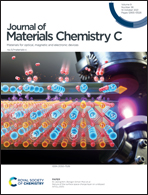Fluorescent magnetic ionic liquids with multiple responses to temperature, humidity and organic vapors†
Abstract
Organic manganese(II) halides have become attractive building blocks for constructing luminescent functional materials due to their excellent optical properties. Here we presented three magnetic fluorescent ionic liquids (ILs) with [MnClxBry]n− (x = 2, y = n = 1 or x = y = n = 2) complexes as luminophores and 1-vinyl-3-butylimidazolium ([C4VIM]+), 1-octyl-3-vinylimidazolium ([C8VIM]+) and 3-dodecyl-1-vinylimidazolium ([C12VIM]+) as organic cations. The three ILs showed green, red and yellow emissions, respectively, with the increasing alkyl chain length at room temperature. All ILs experienced a phase transition from the crystal to the liquid crystal (LC) phase during the heating process, accompanied by the emission color change from green or yellow to red, which was ascribed to the structural transition from the tetrahedral complex [MnCl2Br2]2− to the octahedral species [MnCl2Br]−. Such a thermochromic response was fast, reversible and stable, and more importantly, rarely reported for Mn-based luminescent substances. Furthermore, the emission intensity of the ILs was sensitive to water and some organic vapors. Fluorescent papers loaded with these ILs were prepared in a facile way, and were conveniently used as temperature indicators and organic vapor sensors. This work proposed a simple strategy to prepare luminescent ILs with controlled structures and optical properties, providing more opportunities for the application of IL-based smart materials.



 Please wait while we load your content...
Please wait while we load your content...